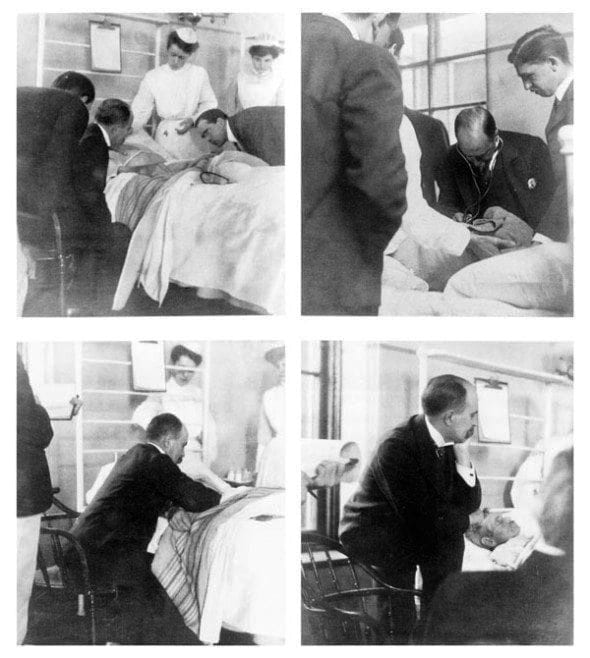Lessons from Osler 004
Treat the patient, not the disease
Care more particularly for the individual patient than for the especial features of the disease
William Osler, Address to the students of the Albany Medical College. Albany Medical Annals. 1899;20:307-309
We enter medical school eager to help the sick and the dying. Over the years this golden objective is transmuted into the base lead of disease-specific diagnostics and therapeutics. Our absorption in the strangeness of the manifestations of a remarkable pathophysiological process may distract us from its impact on the person.
Osler warned us of this danger:
There is a tendency among young men about hospitals to study the cases, not the patients, and in the interest they take in the disease lose sight of the individual. Strive against this. — William Osler
William Osler, Address to medical students at the University of Pennsylvania. 1885
This tendency is dangerous. Failure to temper it comes with undeniable costs. The elderly may die alone in sterile surroundings rather than a home filled with the memories of loved ones. The symptoms of disease may be replaced with the side-effects of therapy. Autonomy may be sacrificed for dependence at the altar of medical paternalism.
This tendency turns us into misguided Ptolemaic medico-astronomers when we forget that the patient is the center of the medical universe. Perhaps we can be forgiven. After all, we find ourselves buried under mountains and mountains of facts and figures and guidelines and ‘the latest’ in evidence. We are stamped and punched with holes by the grinding and boring down of the ‘health care’ machine. We are worn away by the diminishing returns of circadian disruption won by playing a loaded game of roster roulette. And, perhaps the pill that is hardest to swallow, we sometimes find ourselves the target of vehement violence and abuse by those we try to help. Perhaps we can be forgiven for forgetting just what it is that is the Philosopher’s Stone of our profession.
All the more reason to remember the lessons of Osler.

In his or her first days of becoming a doctor, the once and former medical student comes to a deflating realisation. The patients have not read the textbooks or attended the lectures. The child with abdominal pain has pneumonia, the slightly crazy man with all over body ache didn’t even mention chest pain as a symptom of his myocarditis, and the man with the shrinking feet isn’t crazy (even though his feet are not shrinking). Osler reminds us that this state of affairs is nothing new:
Our study is man, as the subject of accidents or disease. Were he always, inside and outside, cast in the same mould, instead of differing from his fellow man as much in constitution and in his reaction to stimulus as in feature, we should ere this have reached some settled principles in our art.
William Osler. Aequanimitas “Teacher and Student” 1914:35
As doctors our learning is a lifelong task. Everyday we learn new lessons. And who teaches us? Our patients. Everyday I hear the words of one of my own teachers, Prof Koelmeyer, who would admonish us to remember that the patient is “our first, last, and only teacher”.
But what of the difficult patient?
Indeed, difficult patients present great difficulties. They sap our physical and emotional reserves, they disrupt the under-oiled workings of the hospital conveyor belt, they confront us, and may even be a physical threat to us or put the ‘Mark of the Beast‘ upon us. The threat of physical violence towards hospital staff is never to be tolerated, no matter who the patient is. However, sometimes this threat comes from those who know not what they are doing. We must guard against making assumptions and try to help. Aequanimitas cannot always be maintained and, sometimes, ‘Freudian slaps‘ will be proffered.
Yet each difficult patient teaches us a lesson. With each lesson we become better at treating difficult patients. With time some patients that we once considered difficult, no longer merit the disdained classification. They simply become patients.
Every patient you see is a lesson in much more than the malady from which he suffers.
William Osler: Aequanimitas “The Student Life” 1914:425.
But treating the difficult patient is made easier by more than just the fact that they are our teachers. They allow us to prove our humanity and remind us why we do what we do.
To serve the art of medicine as it should be served, one must love his fellow man.
William Osler. Modern medicine, its theory and practice. 1907;(1):34
Despite all of medicine’s scientific advances and technological marvels, empathy is still at the heart of our profession. Empathy is a two-way street, there are times when, one way or another, we suffer together with our patients. But what to do when we open the empathy cupboard and find it bare? Sometimes empathy is simply an impossibility, we just have to be professional. But much of the time we just need to think of ourselves — or that still much-loved black sheep among our friends and family — and remember that we also are all too human with our own unique complex of flaws and frailties.
Keep a looking glass in your own heart, and the more carefully you scan your own frailties, the more tender you are for those of your fellow creatures.
Homan E quoting Sir William Osler: Teacher and bibliophile. JAMA 1969;210:2223-5
Though it may be difficult in this era of ‘four hour rules‘ and the tyranny of KPIs, today as in the past, doctors do well to heed Osler’s wise counsel:
The motto of each of you as you undertake the examination and treatment of a case should be “put yourself in his place: realize, so far as you can, the mental state of the patient, enter into his feelings… Scan gently his faults. The kindly word, the cheerful greeting, the sympathetic look.
Penfield W. Neurology in Canada and the Osler Centennial. CMAJ. 1949;61:69-73
Though it is not always easy, or even possible, there is much to be gained by always striving to treat the patient, not the disease.
LITFL Further Reading
- Lessons from Osler 001 – Work, the Master Word in medicine
- Lessons from Osler 002 – Fun and a sense of humor
- Lessons from Osler 003 – the art of observation
- Lessons from Osler 004 – treat the patient, not the disease
- Lessons from Osler 005 – Why examinations are necessary
- William Osler: Oslerisms
- Sir William Osler (1849 – 1919) the history of Osler nodes and ephemeral Oslerisms

eponym
the person behind the name
Chris is an Intensivist and ECMO specialist at The Alfred ICU, where he is Deputy Director (Education). He is a Clinical Adjunct Associate Professor at Monash University, the Lead for the Clinician Educator Incubator programme, and a CICM First Part Examiner.
He is an internationally recognised Clinician Educator with a passion for helping clinicians learn and for improving the clinical performance of individuals and collectives. He was one of the founders of the FOAM movement (Free Open-Access Medical education) has been recognised for his contributions to education with awards from ANZICS, ANZAHPE, and ACEM.
His one great achievement is being the father of three amazing children.
On Bluesky, he is @precordialthump.bsky.social and on the site that Elon has screwed up, he is @precordialthump.
| INTENSIVE | RAGE | Resuscitology | SMACC
